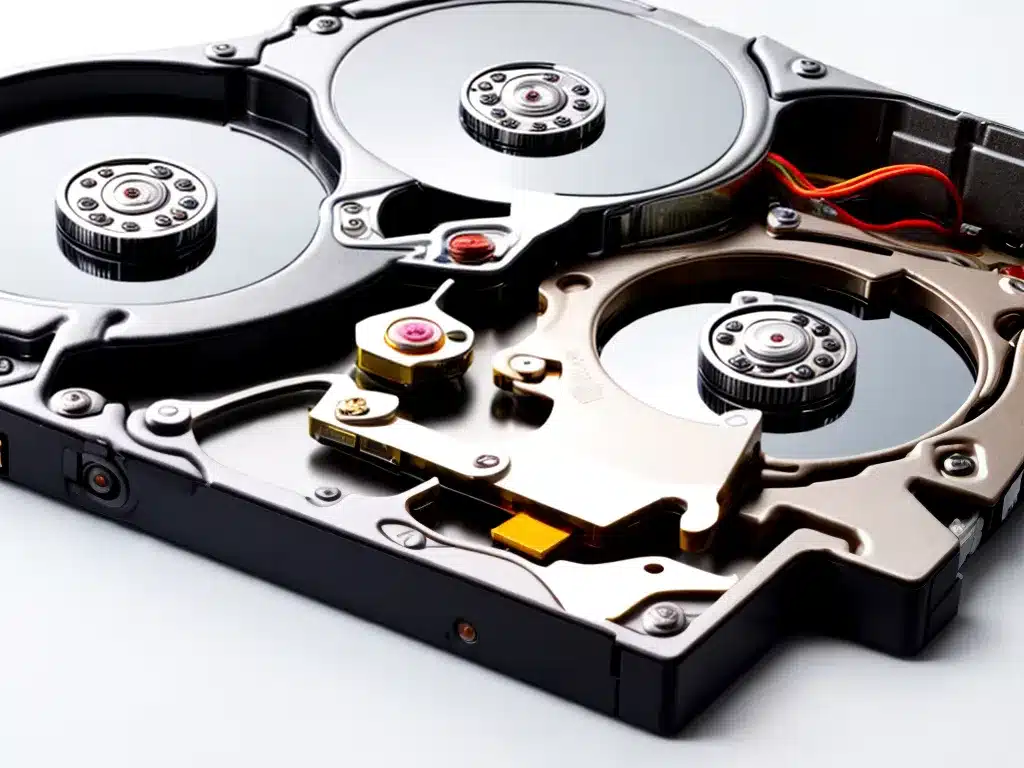
Having a second hard drive is great for extra storage space. But what happens when that second drive stops working and your PC can’t detect it anymore? Don’t panic. Here are some steps you can take to try and get your second hard drive back up and running.
Check Your Drive Cables and Connections
The first thing to check is whether the drive is properly connected.
- Make sure both ends of the SATA cable are securely plugged into the hard drive and the SATA port on your motherboard.
- If it’s an external drive, try unplugging the USB or Thunderbolt cable from both the drive and the computer, then plugging it back in.
- If it’s a NAS (network attached storage), check the network cable connections and make sure the drive is powered on.
Loose connections account for many drive detection issues, so this can often resolve the problem.
Try Another SATA Port
If reseating the connections doesn’t work, try plugging the drive into another SATA port on your motherboard. Use the port recommended by your motherboard manual for your second hard drive.
Sometimes there can be issues with particular SATA ports that prevent proper drive detection. Switching to another port may allow your PC to recognize the drive.
Update or Reinstall Drive Drivers
Drivers enable your operating system to properly communicate with hardware like a hard drive.
- For external drives, update or reinstall the driver software that came with the drive.
- For internal drives, make sure you have the latest SATA/RAID drivers for your motherboard installed. Check your motherboard manufacturer’s website.
Outdated or corrupt drivers can lead to detection issues, especially after updating your OS. Reinstalling the drivers may fix the problem.
Try Another SATA Cable
Damaged SATA cables are another potential culprit for drive detection issues. Swap out the existing SATA cable with a different cable that you know works properly. Preferably use a brand new cable of decent quality.
This is an easy hardware troubleshooting step that could restore communication between your PC and the problem drive.
Check Drive in Another Computer
At this point, try connecting the problematic hard drive to another computer and see if it is detected.
- For external drives, connect it to another PC via USB or Thunderbolt.
- For internal drives, install it in another desktop system if possible.
If the second PC recognizes the drive, then the issue lies with your original computer’s connections, drivers, or motherboard. If the drive isn’t detected on the second system either, then the drive itself is likely faulty.
Examine Drive in Disk Management
Open the Disk Management utility in Windows to see if the drive shows up there but not in File Explorer. Press Win + R and type diskmgmt.msc to launch it.
See if the drive appears in the list of disks in the lower half of Disk Management, just without a drive letter assigned. If so, you can right-click it and choose Change Drive Letter and Paths to add a letter and make it accessible in File Explorer.
Check Drive for Errors
If the drive shows up in Disk Management but is marked with errors or as Offline, it may have corruption issues that prevent it from being detected properly.
- Right-click the disk and choose Properties, then Tools, then under Error checking click Check.
- Use the tool
chkdskin Command Prompt to scan for and repair errors.
This can help fix problems with corrupted system files or bad sectors that may be interfering with drive detection.
Initialize Drive in Disk Management
Brand new drives will be listed as Unallocated in Disk Management. They need to be initialized before your PC can access them.
Right-click the disk and choose Initialize Disk. Select a partition table format like GPT or MBR, and click OK. Now your drive should show up as usable space to create a new volume on.
Format Drive and Assign Letter
If initializing an unallocated drive doesn’t work, the next step is to format it.
- Right-click the disk and choose New Simple Volume. Go through the wizard to format and assign a drive letter.
- You can also use DiskPart in Command Prompt to clean and reformat a disk.
Formatting should make the drive detectable for your operating system, restoring full functionality. Just be aware this erases all data on the disk.
Check for Physical Damage
At this point if your drive is still not detected, physical damage is the likely culprit.
Listen closely to the drive. Are there any unusual clicking or beeping noises? Those are telltale signs of hardware failure.
You’ll need to either replace the drive or consult with a data recovery service. But turning a clicking hard drive off immediately can help prevent further data loss.
Contact Drive Manufacturer Support
For continued issues getting an internal or external hard drive detected, it’s wise to contact the manufacturer’s tech support. Especially if the drive is still under warranty, they may be able to identify hardware defects and help with further troubleshooting or replacement options.
Hopefully some of these steps will successfully get your second hard drive back up and running. Proper connections, updated drivers, fixing errors, and formatting can often resolve many detection problems. But if not, examination of potential physical damage and manufacturer assistance may be required. Be persistent and try all applicable solutions to revive your missing drive.












